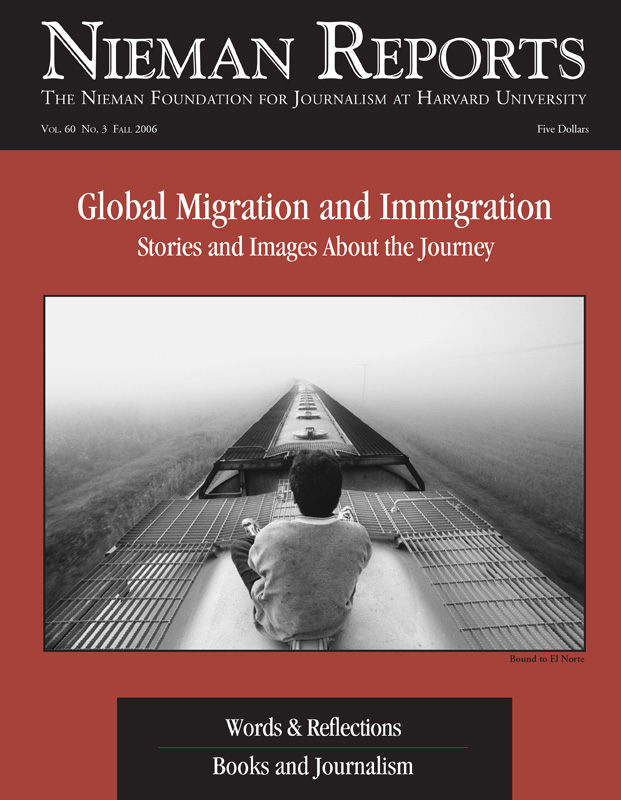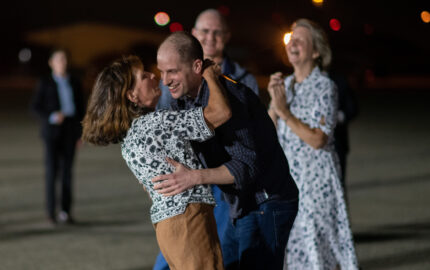
Global Migration and Immigration: Stories and Images About the Journey
When I was a border correspondent, I learned to move between both sides, quickly and frequently, physically and mentally, while striving for balance. I learned to maneuver in gray areas. And I learned there was no substitute for being out in the field, on the street, at the line — talking with migrants and cops and desperados, the gatekeepers of the secret worlds.
Photojournalism finds a welcoming home on the pages of Nieman Reports. On these pages, photo editors have written about the difficult decisions they confront in selecting images to portray the Middle East conflict. Here, photographers display their visual storytelling in essays about their work. On these pages, journalists reflect on the enduring power of the still image, and their words speak to risks — physical and emotional — that photographers take to convey an unimaginable range of human endeavors and feelings. What emerges from their words and images is an awareness of photojournalism as an indispensable part of storytelling.
Photographs force us to confront the raw reality of war, terrorism, famine, and murder. Images from Darfur and Beirut, Iraq and New Orleans grip our emotions. Editors whose job it is to select which images go onto a newspaper's front page or a magazine's cover understand the potency of a single photograph, with its ability to linger in our minds long after words fade away. Mention the flag raising on Iwo Jima, the shootings at Kent State, or the Oklahoma City bombing, and an iconic photograph takes us on a shared journey of memory back to that event.
In this issue of Nieman Reports a collection of remarkable photo essays serves as a major part of an extensive report on the coverage of the migratory journeys of men, women and children who are struggling to reach places that hold the promise of a better life. These photographs provide such powerful witness to the extensive global migration taking place in our time — and to their storytelling strength — that the editor decided to feature them in new ways. In all, one third of the stories in this 70-page report on global migration and immigration are told as essays by photojournalists.
This circumstance reflects the evolving nature of Nieman Reports. Since its inception in 1947, the magazine has gradually altered its content and design, while holding steady to its purpose — to provide a forum for an ongoing conversation among journalists about their roles and responsibilities in an ever-shifting media environment. Editor Melissa Ludtke describes the strength of Nieman Reports as it being among the few places where journalists writing out of their own experiences and sharing their insights about covering events and issues are able to exchange information with their peers about challenges and opportunities they find in their common pursuit.
From its modest beginnings, the magazine continues to be published quarterly, but through the years it has grown to more than 100 pages per issue. With this expanded size comes the opportunity to identify broad journalistic themes or important contemporary issues and devote the space necessary to convey the varied perspectives of reporters and editors, photojournalists and filmmakers, as well as bloggers and citizen journalists.
During the past year, the look of the magazine has begun to change. Under the creative direction of designer Diane Novetsky, some changes are being introduced in this issue in the use of type and the display of photographs. In bringing a more contemporary look to these pages, an effort is being made to strike a balance between important traditions that give Nieman Reports its unique sense of place and purpose and visual changes that will serve to improve and strengthen its relationship with readers. In future issues, readers will likely begin to notice what is new and different about the magazine's design.
Nieman Reports has a strong and vital presence online, as well. Our archive of articles — sorted by the issue in which they appeared — goes back to 1998, and a strategy is under discussion that would create a digital archive of all issues since 1947. Also on the Nieman Foundation Web site are special collections of stories from the magazine. The first of these appeared several years ago when we assembled in one place more than three years of Nieman Reports' stories about the coverage of war and terror.
This year we've begun to utilize eMprint technology, developed by Roger Fidler of the Missouri School of Journalism, to provide easy-to-read online "magazines" full of related stories bundled from our quarterly issues. The eMprint template enables these articles to appear online with the familiar characteristics of their printed form while also, in some cases, using multimedia to enhance the reading experience. Now available as eMprint newsbooks are "Journalists: On the Subject of Courage," "What Katrina Revealed, Will Journalists Now Cover?," "Newspapers' Survival," "The Job of Frontline Editor," "Citizen Journalism," "Intelligent Design," and "Global Warming," which appears also in a multimedia edition with the sound and visuals of icebergs cracking. We hope to soon provide ways for interactive exchanges to take place on the Web.
Photographs force us to confront the raw reality of war, terrorism, famine, and murder. Images from Darfur and Beirut, Iraq and New Orleans grip our emotions. Editors whose job it is to select which images go onto a newspaper's front page or a magazine's cover understand the potency of a single photograph, with its ability to linger in our minds long after words fade away. Mention the flag raising on Iwo Jima, the shootings at Kent State, or the Oklahoma City bombing, and an iconic photograph takes us on a shared journey of memory back to that event.
In this issue of Nieman Reports a collection of remarkable photo essays serves as a major part of an extensive report on the coverage of the migratory journeys of men, women and children who are struggling to reach places that hold the promise of a better life. These photographs provide such powerful witness to the extensive global migration taking place in our time — and to their storytelling strength — that the editor decided to feature them in new ways. In all, one third of the stories in this 70-page report on global migration and immigration are told as essays by photojournalists.
This circumstance reflects the evolving nature of Nieman Reports. Since its inception in 1947, the magazine has gradually altered its content and design, while holding steady to its purpose — to provide a forum for an ongoing conversation among journalists about their roles and responsibilities in an ever-shifting media environment. Editor Melissa Ludtke describes the strength of Nieman Reports as it being among the few places where journalists writing out of their own experiences and sharing their insights about covering events and issues are able to exchange information with their peers about challenges and opportunities they find in their common pursuit.
From its modest beginnings, the magazine continues to be published quarterly, but through the years it has grown to more than 100 pages per issue. With this expanded size comes the opportunity to identify broad journalistic themes or important contemporary issues and devote the space necessary to convey the varied perspectives of reporters and editors, photojournalists and filmmakers, as well as bloggers and citizen journalists.
During the past year, the look of the magazine has begun to change. Under the creative direction of designer Diane Novetsky, some changes are being introduced in this issue in the use of type and the display of photographs. In bringing a more contemporary look to these pages, an effort is being made to strike a balance between important traditions that give Nieman Reports its unique sense of place and purpose and visual changes that will serve to improve and strengthen its relationship with readers. In future issues, readers will likely begin to notice what is new and different about the magazine's design.
Nieman Reports has a strong and vital presence online, as well. Our archive of articles — sorted by the issue in which they appeared — goes back to 1998, and a strategy is under discussion that would create a digital archive of all issues since 1947. Also on the Nieman Foundation Web site are special collections of stories from the magazine. The first of these appeared several years ago when we assembled in one place more than three years of Nieman Reports' stories about the coverage of war and terror.
This year we've begun to utilize eMprint technology, developed by Roger Fidler of the Missouri School of Journalism, to provide easy-to-read online "magazines" full of related stories bundled from our quarterly issues. The eMprint template enables these articles to appear online with the familiar characteristics of their printed form while also, in some cases, using multimedia to enhance the reading experience. Now available as eMprint newsbooks are "Journalists: On the Subject of Courage," "What Katrina Revealed, Will Journalists Now Cover?," "Newspapers' Survival," "The Job of Frontline Editor," "Citizen Journalism," "Intelligent Design," and "Global Warming," which appears also in a multimedia edition with the sound and visuals of icebergs cracking. We hope to soon provide ways for interactive exchanges to take place on the Web.


